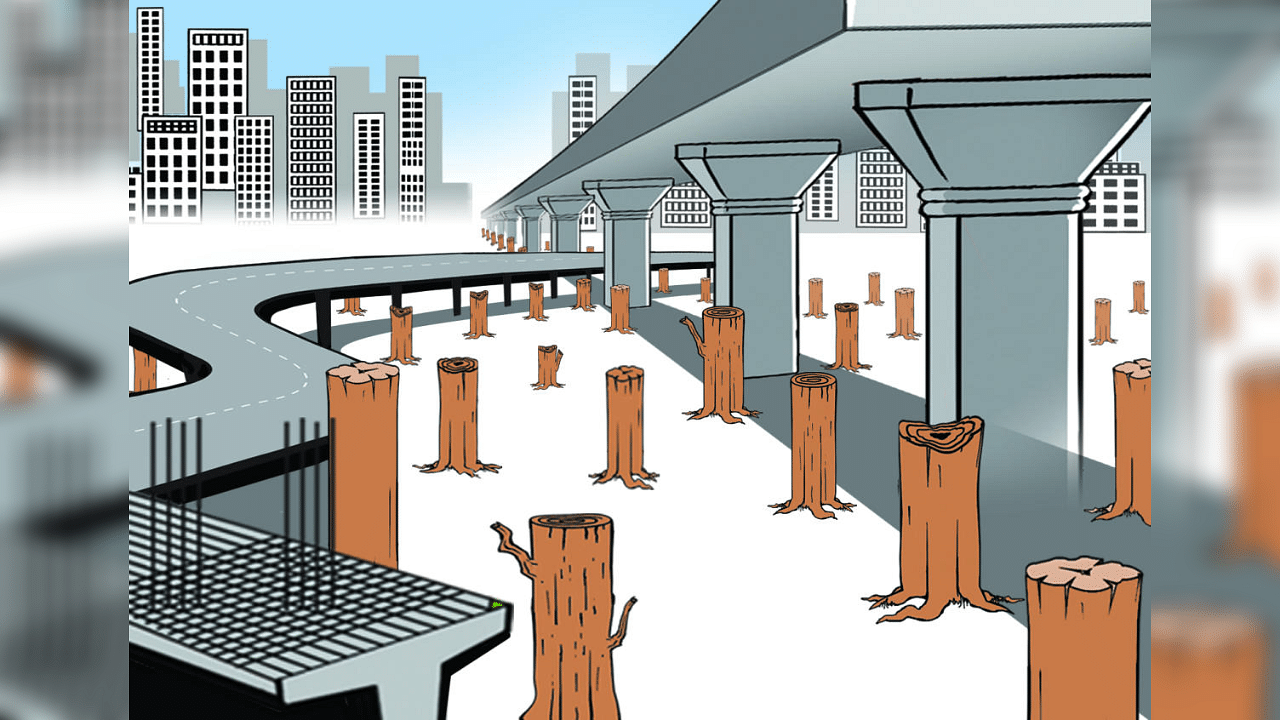
The axe fell again, this time with a brute force so strong that no one had even a second to shout ‘wait!’ Last weekend, as decades-old trees were chopped, sliced and carted away on Old Airport Road, voices of resistance could only watch in shock. The controversial signal-free corridor project had scored another massive point for the motorists!
The project planners had decided that the trees should make way for an underpass at the Suranjandas Road Junction since the corridor mandated it. But, as environmentalists argue, there was an easy way to save those trees: Make the temporary bypass built at the Junction permanent.
Bald stretch
For decades, the spread out, lush green canopies of the now-felled trees had given every passer-by a glimpse of old, green Bengaluru. The bald stretch on Old Airport Road today symbolises everything that has gone wrong with a motorist-oriented development brigade not ready to consult or hear public opinion.
Conceptualised, designed and being built without the mandated public consultation process, the signal-free corridor is heavily skewed in favour of the motorists. On the project agenda are underpasses at Wind Tunnel, Suranjan Das and Kundalahalli Junctions besides a number of skywalks.
The signal-free corridor promises a breezy ride for motorists on Old Airport Road. But pedestrians will be forced to take the skywalks. Senior citizens and the disabled will have to take the lifts, but as argued in these columns, a majority of skywalk lifts in the city remain locked, in disrepair or unbuilt.
Consultation avoided
Three years ago, over 40 trees were chopped for the planned underpass at the Wind Tunnel Road Junction. Today, the underpass is nowhere near completion. “Then they wanted to fell 48 trees at the Suranjan Das Road Junction. The number was deliberately kept below 50 to avoid public consultation,” recalls an environmentalist, preferring anonymity.
The traffic diversions, made at the Suranjandas Junction before the project went into cold storage, has worked well for months. “For motorists heading towards Marathahalli from Manipal Hospital side, the slight diversion to the left at the Junction has been effective. A proposal to make this diversion permanent was ignored.”
Drop in traffic
The Work from Home (WFH) culture that took root in the post-pandemic period has seen a perceptible drop in vehicular traffic on the stretch. Traffic surveys indicate that the congestion is restricted to only a few peak hours. “If there is a reduction, they could have easily managed with the diversions.”
But for the Bruhath Bengaluru Mahanagara Palike (BBMP), the underpass project had to be kickstarted with the green signal obtained from the tree expert committee. Time was up for traffic studies and public consultation. The panel had approved the removal of 23 trees, some of them at least 50 years old.
The Palike’s position was clear: It had followed the High Court directions, planted saplings and even uploaded documents related to the tree-felling on its website. However, green activists who have been actively fighting legal battles to save trees elsewhere in the city and on its outskirts, apparently missed this online documentation.
Documents unseen
An environmentalist notes that the documents were uploaded without file names and were lost in the maze of dozens of other files already placed on the Palike portal. Seasoned activists, who had made timely legal interventions to save hundreds of trees in other projects, missed it and were taken offguard by the tree felling. Citizens were left clueless. Urban conservationist Vijay Nishanth recalls how timely activism had saved 4,000 of the 8,000 trees marked for felling under the Karnataka Road Development Corporation Limited (KRDCL)’s road-widening project. But this too came after 2,000 trees were chopped during the lockdown.
Need to be vigilant
He articulates the need for the public to be more vigilant to prevent indiscriminate felling in the future. But this can make a difference only when every tree identified for axing is checked by the tree panel, the details officially uploaded in a transparent, accessible manner, and public objections recorded judiciously.
But when the alignment of a road/location of an underpass is already decided, can the tree panel make a difference? “The panel does not go into the road alignment or the need for the tree to be retained. Only option given is transplantation, which has had only mixed success. The first priority has to be retention,” the environmentalist notes.
Another veteran green activist feels the complexities involved should have been addressed locally through a participatory process with ward-level oversight.